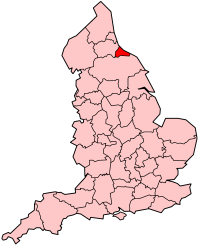Cleveland, England
|
|
 |

|
Cleveland is an area in the north east of England. Its name means literally "cliff-land", referring to its hilly southern areas, which rise to nearly 1,500 ft. Cleveland, mostly part of the North Riding of Yorkshire, was located entirely to the south of the River Tees and its largest town was Guisborough.
Between 1974 and 1996 most of Cleveland was incorporated into a county of the same name, formed from parts of the North Riding of Yorkshire and County Durham. Unlike the traditional geographic area, the county was formed around the Tees estuary and included lands on both sides of the river. It excluded the southernmost parts of traditional Cleveland, including much of the Cleveland Hills, although the original proposal for this county was much larger and covered the coast down to Whitby.
The county was called 'Cleveland', instead of 'Teesside' as originally suggested, due to fears in areas not part of the old Teesside county borough that it represented a takeover.
The four districts of the County of Cleveland were Hartlepool, Langbaurgh-on-Tees, Stockton-on-Tees, and Middlesbrough. The county town was Middlesbrough. It had a total area of 225 miles² (583 km²) and an estimated population of 567,600 in 2000. The county bordered County Durham to the north and North Yorkshire to the south, and it faced the North Sea to the east.
The Cleveland (Structural Change) Order 1995 and The Cleveland (Further Provision) Order 1995 came into effect on April 1, 1996, and renamed Langbaurgh-on-Tees to Redcar and Cleveland, abolished the County of Cleveland and created four unitary authorities in its place. The effect of the second order was to abolish the county utterly. It is not even retained for ceremonial purposes, with the area being split between the ceremonial counties of Durham and North Yorkshire. More commonly however, the area is now referred to as Tees Valley, which covers the four former Cleveland Unitary Authorities together with Darlington. Darlington was previously part of County Durham, but became a Unitary Authority in 1997.
However, the name has not been entirely abolished: Cleveland Police, Cleveland Fire Brigade, BBC Radio Cleveland, the Cleveland Family History Society and Cleveland College of Art and Design still exist.
Cleveland has a significant industrial heritage arising from its central role in the 19th century iron boom that led to Middlesbrough growing from a hamlet into a major industrial town in only a few decades. The Cleveland Hills, in the southern part of the district, were key suppliers of the ironstone that was essential to the running of the blast furnaces alongside the River Tees. Middlesbrough's Teesport is still one of the United Kingdom's main ports and the area between Middlesbrough and Redcar is still populated by many heavy industrial plants, although this is much reduced from its 20th century peak.
The area is extremely varied geographically. The Tees estuary is highly industrialised and urbanised. Much of the remainder of the lowland parts of Cleveland is farmland. East Cleveland marks the northern end of the chain of cliffs that runs along the North Yorkshire Heritage Coast. South Cleveland is extremely hilly, forming the escarpment of the North York Moors. One of the best known symbols of Cleveland is the distinctive hill of Roseberry Topping, which overlooks Newton-under-Roseberry on the Great Ayton to Guisborough road. Its original roughly conical form was undercut by extensive mining, giving it a jagged appearance that many have thought reminiscent of the Matterhorn mountain.
Cleveland is also a Church of England archdeaconry, in the Diocese of York. It covers a large area including Middlesbrough, Thirsk, Pickering and Whitby.
